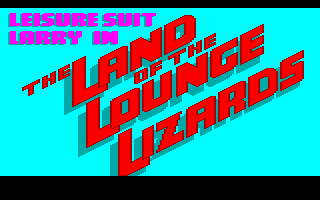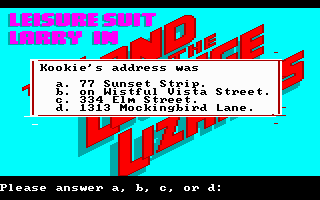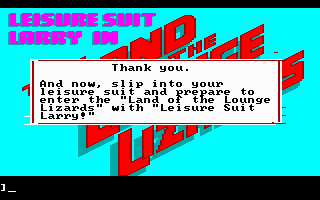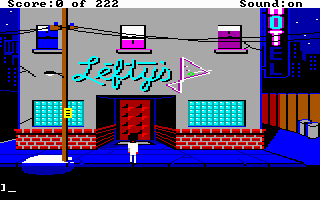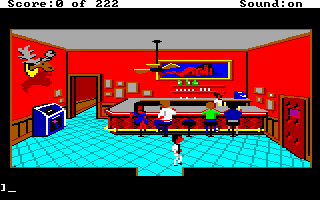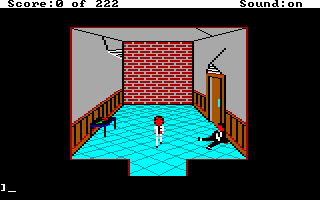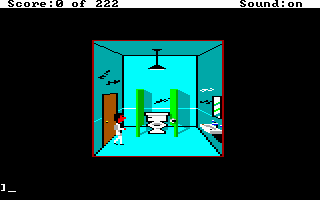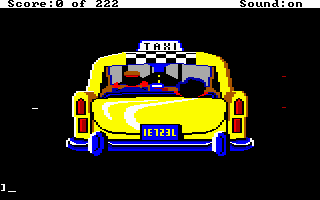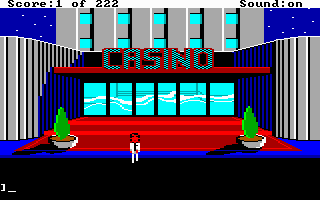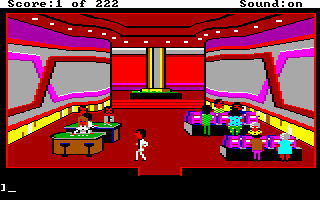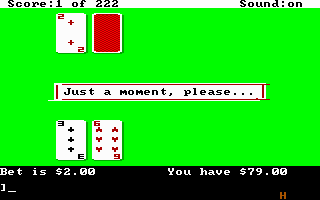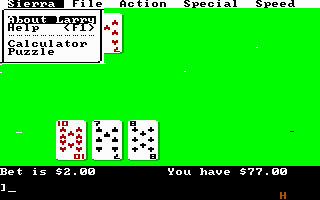Leisure Suit Larry in the Lands of the Lounge Lizards
Released: 1987
Published by: Sierra On-Line, Inc.
Developed by: Sierra On-Line, Inc.
Credits: Al Lowe, Chuck Benton, Mark Crowe, Ken Williams
System Requirements
| System Requirements | 8088 or 8086 and compatibles. 256K RAM required. DOS 2.11 or later. Hercules monochrome/CGA/Composite CGA/EGA/VGA graphics supported. Audio support for PC speaker or Tandy only. Supports a joystick. *An unofficial "experimental" patch allows 3-voice music to be played from an MPU-401 interface* |
|---|---|
| Original Media | Two 5.25" 360 KB (DD) disks (original version 1.00) |
| Installed Size | 540 KB of hard disk space. |
From where can it be run?
From the original floppy disks only.
Game Audio/Video
TBC...
Copy Protection
All versions of Leisure Suit Larry (in fact all AGI2 titles from Sierra) were supplied with the first disk being a "Key" disk - an early copy protection method. Key disks used a track on the disk (usually track 0) that had a checksum error or used a non-standard sector size on that track. The main executable file (SIERRA.COM) would make a check for this non-standard track, and if found would read a decryption key from it and decrypt the real executable file, which is "AGI". This protection was called "SuperLok 3.2".
LSL also has an interesting secondary layer of copy protection, which asks you 5 questions to confirm your age. These are comical in nature, so it's sometimes possible to get them wrong, or fail to recognise the correct answer if you're not from the USA. You are allowed to get one question wrong and still continue, but after 2 incorrect choices you are told you're too young to play, and are returned to the DOS prompt.
How to Setup
The game does not come with a setup program like later Sierra titles. All versions check the BIOS for an ID string that matches an IBM PCjr or Tandy 1000 and will initialise those systems' 3-voice PCG sound data and also load those graphics drivers. However, there are some command-line options to force the graphics mode. Simple run LL.COM with:
- -c Forces CGA Composite colour mode
- -r Forces CGA RGB colour mode
- -h Forces Hercules (HGC) mono mode for TTL monitors
- -e Forces EGA mode
- -v Forces MCGA/VGA mode
- -t Forces Tandy 1000 graphics and/or sound
- -p Forces "PC" mode (assumed to tell it you're running a PC not a PCjr or Tandy)
- -s An unknown flag - not sure what this does
My version of this game has AGI interpreter version 2.917 (the most up-to-date interpreter released for this game), and by default it runs in EGA graphics mode. Running with the -c option worked well. -h wasn't tested as it requires a TTL (digital signal) monitor.
The game doesn't require any extended memory (XMS) or expanded memory (EMS) drivers to be loaded.
Problems
Issue: Corrupted graphics or garbled text, unreadable.
Cause: This can occur if running the game with a modern graphics card under Windows 95, 98 or ME.
Resolution:
Either run it on period-correct hardware (including the graphics card) or run it in DOSBox. There are also several third-party AGI interpreters that fix many bugs when running on more modern computers - try ScummVM or NAGI. There was another called Sarien but that has since merged with ScummVM.
To Quit the Game
Simply type the word "QUIT" and hit enter. Then either hit ENTER again to confirm or ESC to cancel.
Supporting Documents
Here are the original documents that came with the game:
And here are some aftermarket links:
Save Games
The location of save game files is entirely up to you! When you type the word "SAVE" (or press F5) you will be prompted for a directory where you wish the save game file to be stored. By default this will be the same directory in which the executable file was run.
Once you've chosen the location you are shown 12 'slots' in which save games can be stored. Any slots that have a save game already stored will display their description. Once the slot has been chosen, you are prompted to give a description for the save game. Once completed, the save game will be stored in a file called lllllsg.x where x is the slot number from 1 to 12.
This is actually a great way of storing save games, as you are not limited to 12 slots - if you need more you can create a directory anywhere and use that to store a further 12 save games.
To restore a saved game, type the word "RESTORE" (or press F7) and you will be prompted for the location where your save games are stored. By default this will be the same directory in which the executable game file was run. After choosing a drive/directory, the list of save games that exist in that directory are shown. Move the arrow keys to the one you wish to restore, and hit <Enter>.
Versions of the game known to exist
| Version | Date | Comments |
|---|---|---|
| 1.00 | 1st June 1987 | 5.25" 360 KB version. Comes with AGI2 intepreter v2.917. This version of the game only supports CGA, Hercules, Tandy/PCjr and EGA graphics. |
